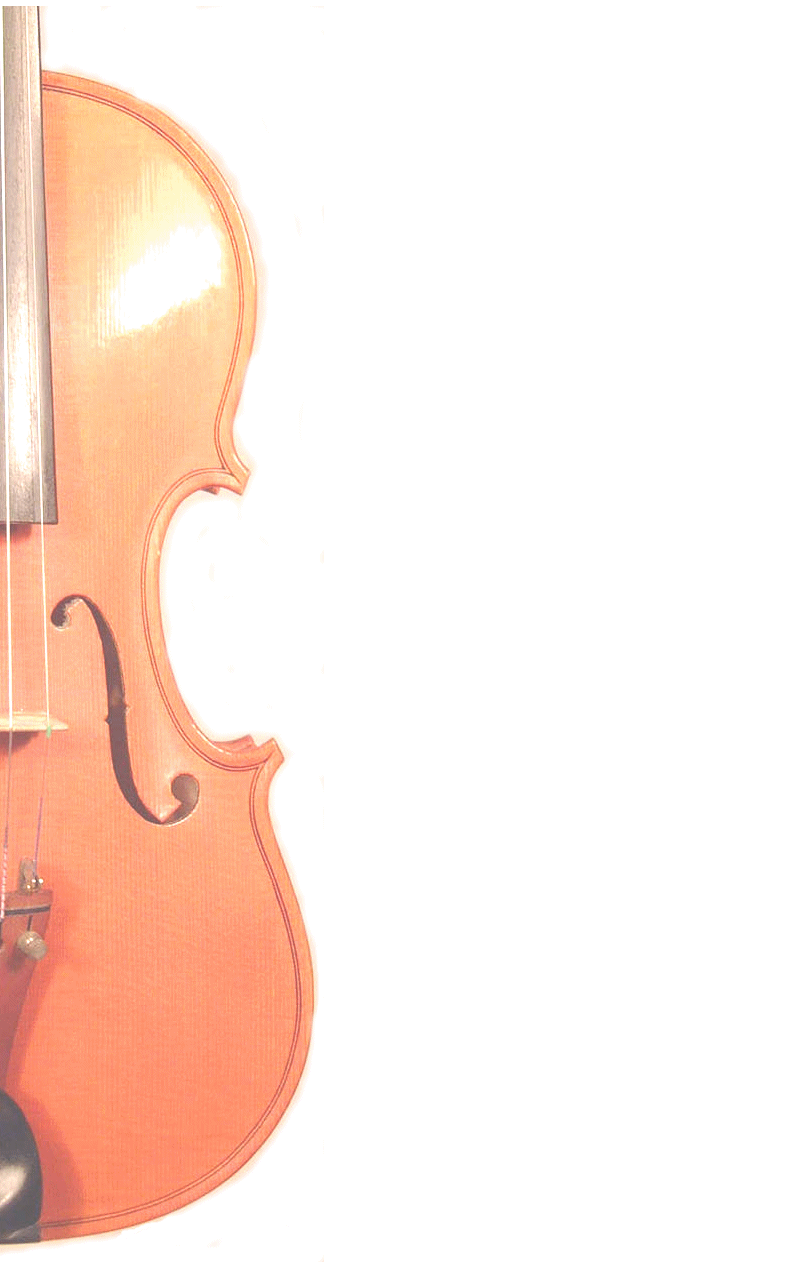 |
 |
| Tuning Your Violin |
The 'A' String Traditionally we tune a violin's A string first. In an orchestra, the A will be played by an oboe. We use the oboe because it is a very unique sound and it is easy to hear. The A that most orchestras use is at a frequency of 440 hz. Some orchestras will use a slightly sharper A (up to 443 hz). No matter what A is used, the other pitches will move slightly sharper or flatter based on that A. Click the A peg, or you can also hear a 440 Hz. A by clicking here. Stop MIDI PlaybackDon't forget to push the peg in as you turn it when you are tuning up.The 'D' String Your violin's D string is the next string you should tune. Use the A string as your reference by playing both the A and D strings at once. The interval between the notes is a 'Perfect 5th' which is the beginning of the song "Twinkle, Twinkle, Little Star" (the pitch of the first 'twinkle' being the lower note (D) and the second 'twinkle' the higher note (A). Use your ears to adjust the D string until you hear the characteristic open sound of the perfect 5th. Click the D peg, or you can also hear a D by clicking here. Stop MIDI PlaybackThe 'G' String Repeat the same steps to tune the G string, using the D string as your higher reference note. Click the G peg, or you can also hear a G by clicking here. Stop MIDI PlaybackThe 'E' String Repeat the same steps to tune the E string. Because it is the most delicate string, and the pitch can be altered easily during the tuning process of the other strings, we tune the E string last. Usually you will be able to use the fine tuner on the E string to make a slight adjustment so that the pitch matches a Perfect 5th above the A string. Click the E peg, or you can also here an E by clicking here. |
Stop MIDI Playback |
| Tuning Tones A D G E |
Stop MIDI Playback |
| Tuning in General Tuning a violin can be a daunting task for beginning violin students. Before I discuss actual tuning, here are some general tips. |
| - Violin Strings are under tremendous pressure. Turning them too far can break the string or even damage the violin. Turn pegs S-L-O-W-L-Y, and just a little at a time. If your violin is equipped with fine tuners on the tailpiece, that may be all you need to turn. - Raise the pitch of a string (make it sound higher) by turning the appropriate peg away from you. Lower the string's pitch by turning it toward you. - If you are using a tuning fork or electronic tuner, let the tone play throughout the tuning process of a string. - Most people find it easier to listen to a string come into tune from the string being too "flat" (too low) rather than from too "sharp" (too "high"). If you need to tune a string you may wish to loosen the string very slightly, then tighten it until it is correct. NOW ON TO THE TUNING PROCESS |
| Remember that each time you tune the string of a violin you change the stress everywhere on the instrument. Once you get the E string in tune, go back and repeat the process starting with the A. If there has been a change it will only be a minor one, so bring the A back into tune. Then the D. Then the G. And finally the E. Two more things. First, if you have new strings they may take a while to settle in. The string stretches. The winding on the pegs tightens up. These things will make the pitch of the string get lower (go "flat"). So check tuning on new strings more often. This goes for ANY stringed instrument, not just the violin. Second, sometimes pegs will slip. You just can't seem to make the strings stay in tune no matter what you do. Unless you have a major problem (in which case you need to replace the pegs themselves -- not very common) you can remedy the situation by using PEG DROPS. This helps keep pegs in place, and is a simple fix in most cases. And when you buy a 1/2 ounce bottle it will last for YEARS. Some folks swear by putting a little chalk or rosin dust into the peg hole or onto the peg itself, but I just haven't had the same success with the home remedy and for the price and the convenience of solving my problem without even having to remove the peg . . . the drops seem like a real bargain to me. The opposite problem, pegs that stick and need lubrication, can often be helped by applying PEG COMPOUND. |